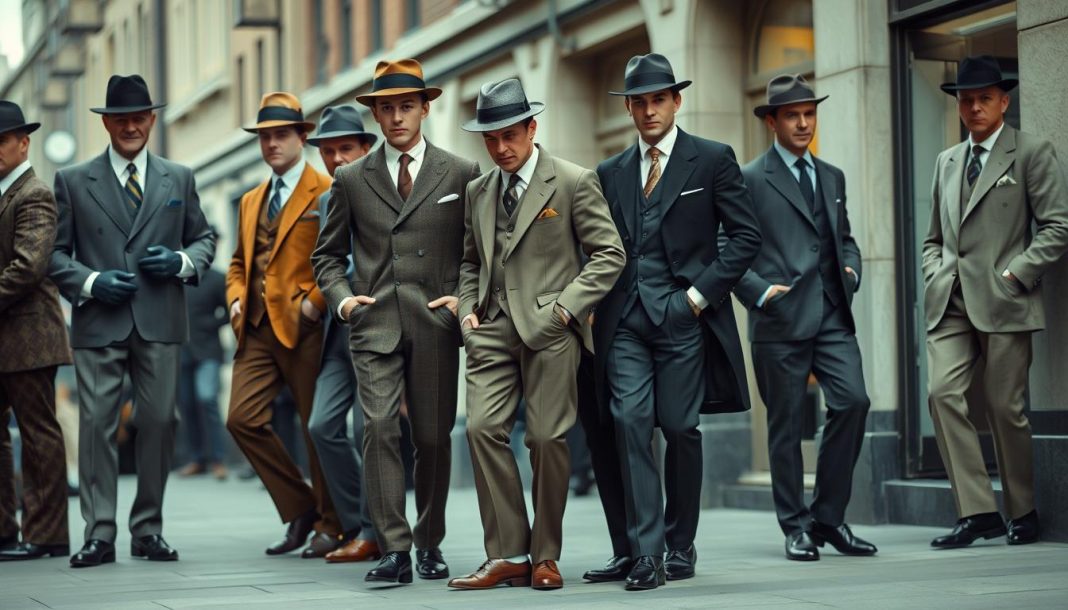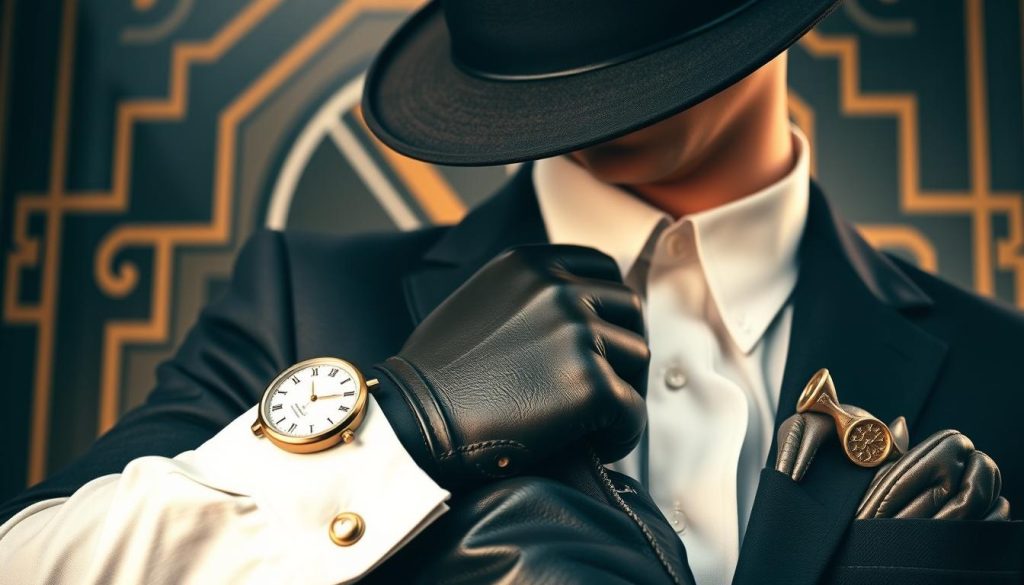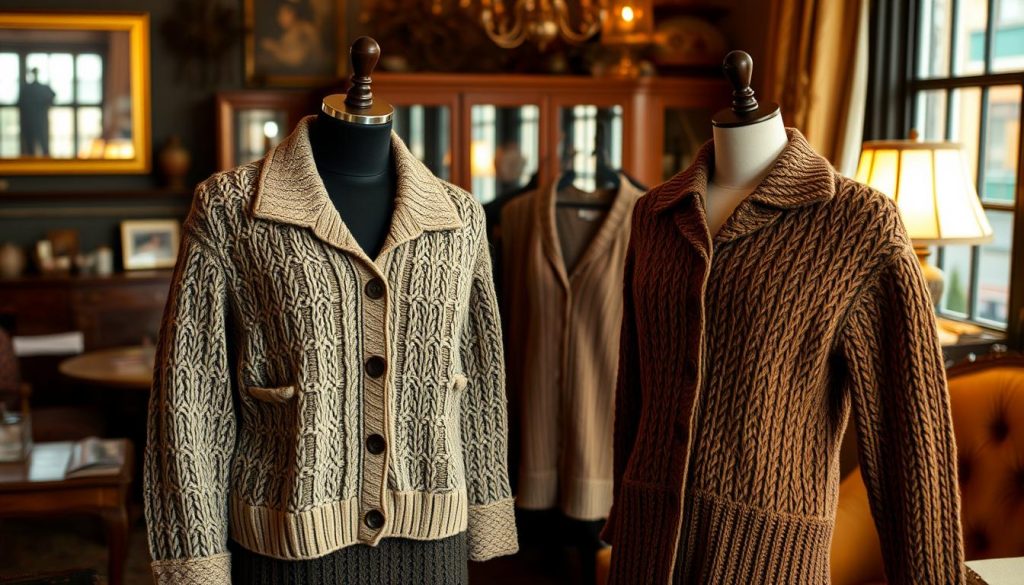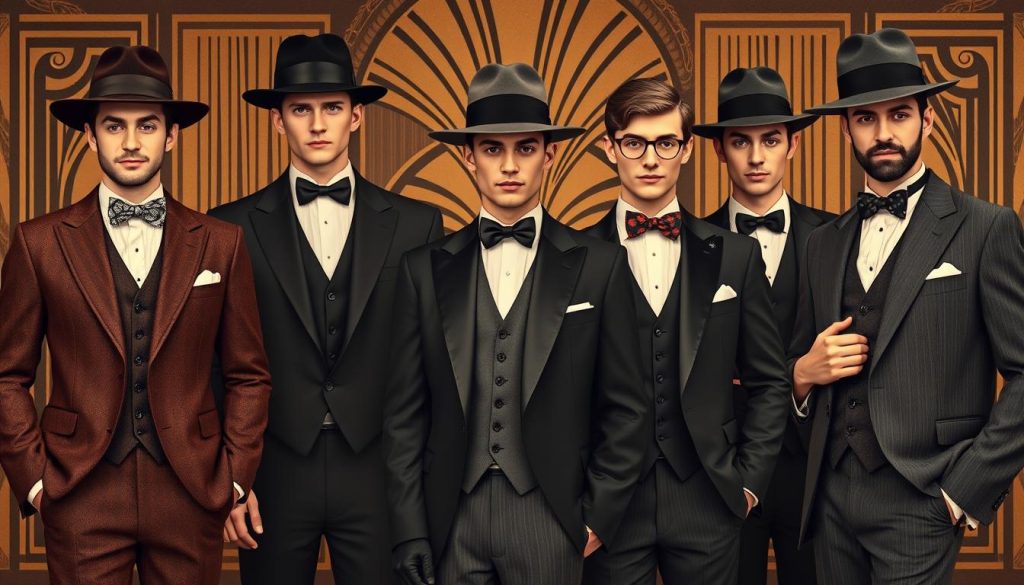At the beginning of the Roaring Twenties, men’s fashion took a colorful turn. Suits came in rich browns, navy, and various patterns like plaid, pinstripe, and herringbone.
This was a big change from the usual black and grey. The 1920s is known as the Golden Age of Menswear. It brought a mix of patterns and textures into both suits and casual wear.
Fedora hats became key accessories, showing off personal style. Trousers got higher waists and wider legs. Modern suits were designed to highlight the waist, with shapes that showed off the human form.
This was a major shift for the era’s fashion. New collar styles also made their debut. They offered more comfort with attached collars, moving away from the stiff, detachable types.
Sports clothes were full of life, with bright, patterned knee-high socks and knickerbockers. The casual side of 1920s fashion included polo shirts and tweed sport jackets. These pieces showed a new sense of style freedom.
Key Takeaways
- The 1920s men’s fashion introduced bright colors and various fabrics, moving beyond traditional styles.
- Jazz age style brought new trends in menswear, emphasizing character and ease of movement.
- The era made comfort fashionable, from shirt collars to the fit of trousers for daytime wear.
- Fedora hats were more than just fashion; they were about showing personal flair.
- The cultural changes of the 1920s had a lasting impact on menswear, shaping today’s fashion.
The Dawn of the Modern Suit: 1920s Mens Fashion Evolution
The 1920s were a key era for men’s fashion. After World War I, society saw big changes. These changes showed up in the styles and materials of men’s clothes.
Fashion liberation became important as people started questioning old norms. This led to big changes in 1920s menswear innovation, especially in suits and their materials.
A Historical Snapshot: Post-WWI Fashion Shifts
After World War I ended, there was economic growth and cultural shifts. These influenced post-WWI styles greatly. Men left behind the dull, tight clothes of war times.
They chose styles that were both comfortable and stylish instead. They started using vintage suit materials like tweed and soft wool. These materials were both durable for daily use and luxurious for leisure activities.
The Impact of the Jazz Age on Men’s Wardrobe Choices
The 1920s, also known as the Jazz Age, were a time of revolution in music and fashion. Jazz Age fashion had a big impact on men’s clothing, bringing Jazz suits to popularity.
These suits had slimmer looks, higher waists, and features like slanted pockets. They were stylish yet fun, different from the traditional styles. This era’s fashion showed a mix of luxury and new social freedoms, reflecting the lively jazz music.
Suit Silhouettes and Materials: From Heavy Wool to Casual Linen
With fashion liberation, 1920s suit silhouettes changed a lot. They went from tight designs to ones that showed natural body shapes.
This time introduced lighter materials like linen. Linen paired well with the more elegant look of tweed country wear. Clothes from the 1920s showed you could be practical without giving up elegance.
By the decade’s end, men’s fashion meant having versatile, stylish essentials. These were perfect for both form and function.
Looking back at 1920s menswear shows it was a time of big change. It wasn’t just about new styles but also setting the future of menswear.
From embracing fashion liberation to trying new materials and silhouettes, each shift paved the way to the future. A future where being comfortable didn’t mean sacrificing style.
Decoding the 1920s Style: Men’s Daytime Attire Explored
Exploring the 1920s, we see a time when men’s fashion made a statement. Everyday outfits showcased structured elegance. Three-piece suits became essential for the stylish man.
These suits had wide lapels, signaling a fresh fashion sense. Paired with them, trousers showed off stripes or plaids. They were high-waisted, widening at the legs for a bold look. This period’s day fashion was all about being sharp and formal, a style that still influences us.
Shirts changed too, with softer turndown collars becoming popular. This change reflected a society leaning towards more relaxed wear. It showed a mix of comfort and style, fitting the era’s leisure activities.
Footwear and accessories played a big role, with Oxfords and brogues being top choices. These classic shoes, in black or brown, kept outfits looking formal.
Knitwear also rose to the scene for less formal times. It was perfect for a relaxed, yet stylish weekend look, marking a shift in men’s fashion choices.
| Attire Type | Description | Typical Colors |
|---|---|---|
| Morning Suit | Formal daytime attire, featuring a tailcoat and striped trousers | Black, Dark Grey, Buff |
| Lounge Suit | Standard informal wear, usually a single or double-breasted suit | Navy, Grey, Black |
| Knitwear | Casual sweaters or vests for relaxed moments | Varied, often in muted tones |
Looking at these fashion pieces, we learn about the era’s social and economic impacts on style. The 1920s men’s fashion shows a mix of function and flair. It offers insights for those diving into vintage fashion’s history.
Evening Elegance: Black Tie & Formalwear of the Roaring Twenties
The 1920s tuxedo style brought charm and sophistication to nighttime events. Men wore these suits, in black and deep midnight blues, as the height of roaring twenties evening wear.
Formal menswear accessories like vintage cufflinks and 1920s pocket squares boosted individual style. These weren’t just extras. They were key to the 1920s’ elegant vibe.
The Tuxedo’s Transformation
The 1920s tuxedo, a formal wardrobe staple, changed a lot during the decade. Traditional top hats and tailcoats were for the more conservative. Yet, the tuxedo coat was loved by the stylish for its comfort at formal events.
The dinner jacket also became popular, especially with young men. It was less formal but had a young appeal.
Accessorizing with Cufflinks, Pocket Squares, and Patented Shoes
Accessories like waistcoats were detailed, with deep U shawl collars, in black or white. The latter for very formal events. Footwear transitioned from black patent leather slip-ons to lace-up Oxfords as the 1920s went on.
Patterns and colors for accessories also changed, reflecting fashion trends. Silk ties went from narrow to broader. Colors and patterns, like stripes and plaids, expanded too.
| Accessory | Material | Color | Pattern |
|---|---|---|---|
| Cufflinks | Silver, Gold | Black, White | Art Deco |
| Pocket Squares | Silk | White | Subtle Stripes |
| Shoes | Leather | Black, Navy | Patinated |
Detailing in accessories like 1920s pocket squares and vintage cufflinks was crucial. They polished the look of 1920s tuxedo style.
Accessorizing the 1920s Man: Hats, Watches, and More
The 1920s fashion scene’s magic isn’t complete without its accessories. This era brought a mix of elegance and usefulness in men’s fashion. It marked a brave move towards modern styles.
The Fedora: A Signature Piece of the Era
Fedoras were the stars of the 1920s hat scene, embodying sophistication and charm. Not just practical, these hats also expressed identity. Their unique shapes and styles showed off a mix of casual and elegant vibes.
Wristwatches and Art Deco Influences
Wristwatches started to replace pocket watches in the 1920s, bringing in the Art Deco design. These watches featured beautiful shapes and lavish designs, highlighting a merger of function and luxury. This change was a sign of growing personal expression and tech progress.
Leather Belts Over Suspenders: A Sartorial Shift
In the 1920s, pants support shifted from suspenders to leather belts. This change brought belts into focus for their style and customization. Belts became a key part of a man’s look.
These fashion pieces didn’t just improve the 1920s man’s outfit. They also showed a shift towards more personal and expressive dressing styles.
Accentuating Casualwear: Knitwear, Cardigans, and Soft Collars
In the 1920s, men’s fashion took a turn towards more comfy styles, blending ease with style. This period welcomed the 1920s casual attire, bringing soft collars and a laid-back vibe to relaxed menswear. Knitwear emerged as a leisure symbol, combining practical use with elegance.
Back then, vintage knitwear showcased chunky shaker and cable knit designs, complete with unique roll collars on pullovers or stylish shawl collars on cardigans.
These pieces didn’t just offer warmth; they also brought a sophisticated yet easygoing look that defined 1920s casual wear.
The cardigan, a vital piece of vintage knitwear, gained fame among the elite and became essential for sports and casual wear.
Boxing champ Gene Tunney and other celebs made the cardigan mainstream, showing it off as both practical and fashionable. Its flexibility made it perfect for slight chills and as a layer in the cold.
Adding these old-school styles to today’s wardrobe tips the hat to yesteryears while keeping your look modern.
It’s about picking items that echo the aura of 1920s knitwear, like patterned cardigans or snug pullovers, and matching them with today’s relaxed menswear vibe.
| Decade | Styles | Popular Colors and Patterns |
|---|---|---|
| 1920s | Heavy chunky knit, roll/shawl collars | Brown with burgundy, blue with pea green |
| 1950s | Slim silhouette, high crew necks | Pastels, winter ski knits, contrast trim |
| 1980s | Oversized fit, novelty characters | Bright, clashing colors, abstract designs |
| Modern | Versatile style staples | Adaptive colors and patterns based on seasonal trends |
Embracing vintage knitwear does more than just make a wardrobe unique. It also honors the 1920s, a time when mixing function with style became critical in relaxed menswear.
Style Icons & Influencers: The Men Who Defined 1920s Mens Fashion
The 1920s marked a key time for men’s fashion, shaped by both style icons and big societal shifts. Figures like the Prince of Wales and jazz musicians led the change. They made a deep celebrity fashion influence that lasts even today.
In this vibrant era, the Prince of Wales, later Edward VIII, played a major role. He brought his sleek, tailored style to the era’s fashion.
He pushed tweed suits and made golf clothes stylish worldwide. Jazz musicians’ style, on the other hand, was bold and colorful. It mirrored their expressive music and life choice.
From the Prince of Wales to Jazz Musicians
The influence of these style influencers was incredible. The Prince brought in elegant patterns and shapes still loved today. Meanwhile, jazz stars like Duke Ellington shone at New York’s Cotton Club. They wore sharp suits and fedoras, defining the Roaring Twenties’ nightlife.
Celebrity Impact on Public Fashion Sensibilities
Celebrity fashion impact reached beyond just the style icons. Sports heroes and Hollywood stars made high-fashion accessible for everyone.
This shift brought men’s daily wear to a new level of laid-back elegance. It shows the deep effect of 1920s menswear impact on everyday style.
The 1920s were about more than just fashion changes. They were a revolution driven by era’s icons, from nobility to performers. Their mark on modern men’s fashion shows how deep true style innovation can go.
Grooming Revisited: Facial Hair and Grooming Trends in the 1920s
In the 1920s grooming trends, men’s grooming habits took a sharp turn. They favored the clean-shaven look and neat facial hair styles. This change aimed for a cultured look that showed class and manners.
The big trend in the 1920s was a smooth, clean-shaven face. This became popular during and after WWI. The need for gas masks that fit well made shaving a necessity. Still, some older men wore mustaches as a symbol of maturity and knowledge.
- The slicked-back hairstyle, achieved using pomade, catered to the desired smooth and shiny finish that was immensely popular among men during the decade.
- Conversely, the side part and undercut styles represented both the refinement and rebellion of the era—fitting neatly with both formal and more casual attire.
Grooming products evolved too. People used to use bear fat. By the 1920s, pomades with beeswax or petroleum jelly became popular. These offered a less greasy look and better styling.
Cultural icons from films and jazz influenced grooming in the 1920s. The decade welcomed a variety of grooming products. This included items for beards and mustaches, meeting the needs of men who valued detailed grooming routines to showcase their facial hair styles.
The 1920s were a turning point for male grooming, blending function with fashion. The basis set during this iconic era continues to influence modern grooming.
The Lasting Legacy of 1920s Mens Fashion: A Modern Resurgence
The roaring 1920s changed menswear a lot and still influences fashion today. With a mix of old and new, modern styles are inspired by the 1920s. This blend keeps the look fresh and appealing.
Twentieth-Century Fashion in Twenty-First Century Style
After the First World War, men’s suits became softer and sleeker. Gone were the stiff, military-like suits, replaced by ones with narrower lapels and shorter jackets.
Now, we see a harmony of old and new in men’s style that focuses on being versatile and practical. Groomed beards and neat haircuts go well with these tailored suits, giving men a smart yet easygoing look.
Reviving the Classics: Incorporating Vintage Elements Today
Today, vintage menswear is back in style, mixing classic 1920s fashion with modern trends. Iconic 1920s pieces like knitted sweaters and wide-leg pants are fashionable again.
The Jazz Age also brings back bold patterns and luxury fabrics, such as wool and silk, into modern clothing. Even gangster-style pinstripes and fedoras are popular today, but with a twist of bright colors.
It’s not just clothes; accessories from the 1920s like cufflinks and pocket watches are also in vogue. These pieces highlight an eye for detail that makes any outfit stand out as sharp and sophisticated.
| 1920s Style Elements | Contemporary Interpretation |
|---|---|
| Soft shoulders and narrow lapels | Adapted in modern slim-fit suits |
| Wide-legged trousers | Reimagined in today’s relaxed-fit pants |
| Sports-inspired attire | Popular as casual modern streetwear |
| Gangster-inspired pinstripes | Integrated into fashion-forward business wear |
| Fedora hats | Still fashionable, adding a retro flair to outfits |
| Classic grooming standards | Modern adaptions seen in barber shops and grooming products |
Conclusion
We wrap up the story of fashion from the 1920s. It was a time of great style and big changes. The classic looks from back then, like high-waisted pants called “Oxford bags,” are still in vogue today.
Check them out at vintage style legacy. Luxury brands such as Kiton and Cesare Attolini have taken cues from these designs.
Fashion back then brought us double-breasted suits with wide lapels. It made men’s clothing more about comfort and looking good, leading to softer shirt collars.
The impact of 1920s menswear sticks with us through the use of materials like wool and tweed for suits. V-neck sweaters and cardigans also reflect that era’s elegance.
Today, brands like Brunello Cucinelli and Stefano Ricci mix old and new styles. They prove that the charm of the 1920s still fits perfectly into today’s fashion.
Looking back, the 1920s menswear was more than just clothes. It was a movement that reshaped future fashion.
It set new standards and left a legacy that still encourages designers to be creative. As we end our fashion history tour, it’s clear. The spirit of the 1920s fashion is tightly knit into today’s style stories.
FAQ
What were some defining characteristics of 1920s men's fashion?
1920s men's fashion showed freedom after World War I. It included colorful patterns and higher-waisted trousers. Suits became more comfortable yet stayed stylish, following Jazz Age trends.
How did post-WWI impact men's fashion in the 1920s?
After WWI, men's fashion changed due to shifts in society and culture. Comfort and style both became key, leading to casual yet chic Jazz suits and new suit materials.
What were typical daytime attire and styles for men in the Roaring Twenties?
Men wore three-piece suits with wide lapels and high-waisted trousers by day. These suits were often striped or tweed. Shirt styles varied, and knitwear became popular for casual wear.
What constituted evening elegance in the 1920s men's formalwear?
Evening wear was luxurious, featuring tuxedos with satin and grosgrain details. The look included tailored tailcoats, white shirts, and accessories like cufflinks and patent leather shoes.
How did hats and watches serve as fashion accessories in the 1920s?
Fedoras and straw boaters became key accessories for a personal touch. Wristwatches, inspired by Art Deco, became more popular than pocket watches, showing off the era's innovative trends.
What style icons influenced 1920s men's fashion?
The Prince of Wales made the fedora popular. Jazz musicians were known for their stylish suits. Celebrities, including athletes and actors, greatly influenced men's fashion.
What grooming trends were prevalent among men in the 1920s?
In the 1920s, men preferred a clean-shaven look. This trend started during the war and carried on, making facial hair less common among the young.
How is 1920s mens fashion relevant to today's styles?
1920s men's fashion is back in style now. People mix classic suits and accessories with today's fashion, creating a timeless yet modern look in menswear.
How can I incorporate 1920s fashion elements into today's wardrobe?
To add 1920s vibes, opt for slim-fit tweed suits and fedoras. Pocket watches and the grooming style of that time can also give a modern outfit a vintage twist.
Why does the 1920s menswear hold a lasting legacy in fashion?
The 1920s menswear is still influential because it introduced freedom, elegance, and innovation in dressing. Its impactful designs continue to inspire modern fashion, maintaining a valuable legacy.





